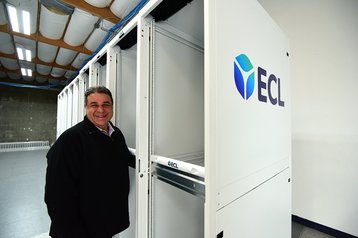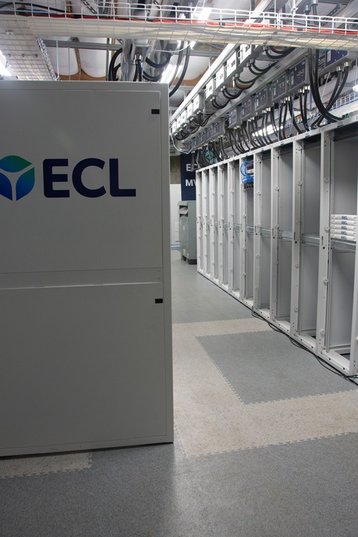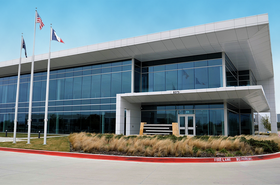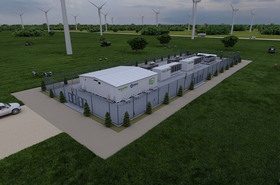“This is not a prototype,” says Yuval Bachar. “It’s a working site. It’s production quality.”
Back in January 2023, Bachar told us that his brand new company, EdgeCloudLink (ECL) would build modular data centers, running on their own hydrogen-powered microgrids, and make them using 3D printing construction.
One year on, he tells us that it is job done. He is doing the final stages of integration and commissioning a 1MW data center, running on fuel cells, at ECL’s headquarters in Mountain View, California.
The facility, built with $7 million of startup funding from Molex and Hyperwise, takes hydrogen by truck from a local source, uses a proprietary liquid cooling design, and has no diesel generators, using batteries and the utility grid for backup.
The only part missing so far is the 3D printing: ECL had a vacant warehouse on its plot, so this time around, there was no need to call on the construction printing contractor it had lined up. Bachar assures us that reusing a building is greener than printing a new one and when 3D printing is needed, it will be the “easy” part of delivering a data center.
“ECL developed a fully sustainable data center which is running on a hydrogen microgrid, not connected to the grid,” he tells us. “We can run our data center at 50 to 75kW per rack, and we operate at a PUE [power usage effectiveness] of 1.1, or better.“
At $7 million per MW, the proposal will undercut both cloud and colocation services, he says. With a delivery time of eight months, it can out-deliver them. And, depending on the source of hydrogen, it will also have remarkably low CO2 emissions.
The pitch is a “zero-emission, zero water use community-integrated data center." That means one that contributes to the community - potentially offering heat, spare generating capacity when needed, and clean water as a by-product of its fuel cells.
“We have zero emission and zero water use on our site,” he says. “We don't use any water from the community or energy from the community around us. On the contrary, we give back water to the community. That was our vision a year ago, and we have actually materialized it.”
When DCD last spoke to Bachar, who has previously held senior data center positions at LinkedIn, Facebook, Cisco, and Microsoft, he was doing the final stage of integration and commissioning at the site, preparing to run 24/7 on hydrogen with a “very strong battery backup system.”
The facility fits into a 1,000 sq ft (93 sqm) space in a building, occupying a total of 4,500 sq ft (418 sqm).
Designing for hydrogen
It has a completely redesigned power system, he says: “It’s a highly flexible power distribution system, built on top of the hydrogen energy source. We eliminated the diesel generators, we eliminated the UPS systems, and we created a 4-source active-active solution.”
In Mountain View ECL gets its fuel by truck: “We bring a tanker every seven to eight days and it refuels and refills our onsite storage.”
Bachar would prefer to have a hydrogen pipeline, and thinks these are on the way: “You have a significant amount of pipelines in the United States, and I think there's a tremendous effort right now in Europe to build new hydrogen pipeline,” he says. “The best way to actually get the hydrogen is to connect to a pipeline.”
ECL’s vision of multiple modules on a site will have to wait for the economy provided by a pipeline: “You get a reasonable price and you can create almost unlimited size data centers,” Bachar says.
Using tankers places a limit on the capacity of a site, Bachar explains. “How many times do you want to bring in a refueling tank? If you don't want to do more than two refuels per day then the size of your data center is limited. Around 15 to 16MW it's starting to be a challenge. Unless these are hydrogen-powered trucks, it’s actually hurting your sustainability claims.”
ECL is working with delivery companies on getting hydrogen-powered trucks, he says “as well as actually trying to focus our energy into places that can get their hydrogen from a pipeline.
A lot of hydrogen reporting concentrates on the spectrum of hydrogen sources available. “Black” or “brown” hydrogen is made from fossil fuels, and is arguably worse than its fossil sources, as energy is lost in the process.
Bachar disagrees: “We will show publicly in the next few weeks that getting hydrogen from any source and any color today to run data centers is superior to any grid in the world from a sustainability perspective. Even if you take a gray hydrogen and deliver it by a truck you're still going to cut the emissions of the data center by 60 to 70 percent.”
Green hydrogen is fully sustainable, but other sources of hydrogen will deliver a “dramatic” improvement in power consumption and carbon footprint, Bachar says. “People don't usually don't look at what is the carbon footprint they get from the grid,” he adds. “Even in California, with one of the greenest grids in the world, you can cut your carbon emission by 60 percent if you deliver any kind of hydrogen.”
His advice is to optimize a data center to use hydrogen first: “Then you source the hydrogen from the most cost-effective and sustainable source. We're currently getting a blend of green, blue, and gray, and we are striving to get green only,” he says.
“By late 2025 or early 2026, we'll be able to supply green hydrogen to every location that we need in the United States - and hopefully in Europe as well.
“Until that time we'll do a blend, targeting ‘blue’ hydrogen, which has had carbon capture on it when it was produced - so it has a relatively low carbon footprint. In the worst case scenarios, we will blend blue with gray with green.”
Data center operators’ experiments with hydrogen have included a 3MW generator powered by fuel cells, built by Microsoft in 2022, but most people appear to regard hydrogen as a possibility for the future.
Bachar admits the hydrogen economy is “evolving in different areas of the world at different paces,” but says the US is in front thanks to the Biden administration’s strategy to create hydrogen hubs across the country, with a goal of getting the price of hydrogen to $1 per kilogram by 2031.
This is still a long way off, as pump prices in California were at $36 per kg last year. But even so, Bachar claims it is possible to “create energy with hydrogen prices today at a competitive level to what you can get from the grid.”
He says: “We can’t compete very well where the electricity price is two cents or four cents per kiloWatt hour, but from eight cents to 50 is the area where we operate.”
Overall, other factors combine to give a hydrogen facility a lower total cost of ownership (TCO), he says: “We can beat about 60 to 70 percent of the grid prices in the US and in Europe, and within the next two years we'll be able to beat almost 100 percent of the grid prices.”
Availability beats price
“That is,” Bachar continues, “assuming that the grid is available.”
In many places data center builders are facing long waiting lists for connection to the grid at all, but a hydrogen facility can be built more easily: “We can drop this in any place,” Bachar says. “Ashburn, Virginia, does not have any power available until 2029. We are probably the only company who can actually build now in Ashburn Virginia.”
Quick power makes a big difference: “Because we're not connecting to the grid, we can turn around our data centers in eight months so from the moment the customer comes and says ‘I want this size of data center in this location’. When traditional methods can take five years to actually deliver a new site, that is very attractive in a high-demand environment.”
ECL is aiming the facility, not at hyperscalers, but at end-user customers who own their IT equipment: “We created the solution to be a colocation site or a private data center for the customer,” Bachar says. And it can be installed “in any location they want because we are grid agnostic.”
Design
The design has a slab floor, so it went into the warehouse space without any major changes.
It has a water-based cooling system: “We're using rear-door heat exchangers to cool the racks. That's how we achieve that level of density with no hot-aisle, cold-aisle isolation,” Bachar explains.
ECL stopped short of immersion cooling because Bachar believes it's not ready, it is not approved for powerful AI processors, and is mostly being hyped at the moment: "Most techs in data centers will not accept it,” he argues. “If you tell a data center tech to get a server out of the tub and deliver it dripping into the maintenance area, that's going to be very difficult."
Bachar says the power conditioning system is an integral part of the data center: “It's not sitting in a separate mechanical or electrical room. It's actually right there.”
The facility has hydrogen fuel cells, batteries, and cooling systems all put together in a block. “Each block has its own power conditioning system and power distribution system using busways.”
The power system and the rear-door cooling means ECL can give each rack a different density from 5kW to 75kW. “It gives us the flexibility to change the power per rack and do a mix and match of different powers.”
With no diesel generators, the facility has a Tesla Megapack battery that can keep the site online for eight hours. The facility is run by ECL’s own management system.
The facility is not doing commercial work. It’s a showcase for customers: “We'll do testing and bring customers to test their workloads on-site till they feel comfortable with our architecture and technology,” Bachar says.
Large potential customers will be let loose on up to 10 racks, the CEO added.
ECL will also have its own separate high-density racks to show the design off: “We are working to put some AI machines there, in a super pod or a supercomputer footprint, to demonstrate the density capabilities - because most customers will not be able to bring in 50 to 75 kW on day one.”
Direct DC power
Running high-density racks from a local power source has given ECL the opportunity to rethink how power is moved around the building.
Most data centers use AC bus bars to get electricity from the outside world to the racks, then convert it to DC for the electronics in the racks. Since the fuel cell natively produces DC power, Bachar sees no reason to convert it twice, losing power each time.
“We can actually drive any voltage of DC, or we can drive AC,” he says. “For us, DC is better because we save stages of conversion.”
Selling capacity in 1MW units, ECL plans to give the customer the choice in future builds: “We can drive a blend of them as well. You can have half DC, half AC if you want.”
Setting up DC bus bars could be a challenge if power densities go too high, and the voltage remains comparatively low, he says. “At the amount of power that we use per rack, we're going to have to drive thousands of amps at low voltage into distribution systems,” he says. “You could be close to 10,000-15,000 amps. That requires pretty special copper distribution.”
He is using higher voltages, which means a more reasonable level of current, and then stepping the voltage down at the racks. “We're trying to put the voltage high enough to be safe,” he says. “For 1MW, we push at 800V, 750V, or 700V. That’s about 2000A, which is reasonable. To increase that five times or six times would be a nightmare.”
Helping out
Running high-temperature fuel cells on site, as well as racks of high-powered servers, ECL has a stream of potentially useful by-products: “We are producing a tremendous amount of hot water that we can distribute. We do not need it,” he says.
How much gets reused will depend on where a future facility is located: “If we are close to the urban area, it makes sense to actually distribute it,” Bachar says. “If we're far away from the urban area we can distribute into the building itself for heating.”
The hydrogen fuel cells generate water, which is recycled into the data center at present. “The data center does not use water, because we actually have a factory [the fuel cells] which produces water.”
But because the cooling circuit is a closed loop with low loss, there will be a surplus of water. “We have four external loops around the data center. Some of them use some of the water that we actually produce but we definitely have an overproduction of water that we will give, in a cold state or a hot state to our neighbors.”
In Mountain View, ECL is planning to offer the water for irrigation, Bachar says. “There's a lot of neighbors over here that require high levels of water, and we're just going to give it to them,” he explains.
Ironically, what the fuel cells create is actually too pure for irrigation: “The funny thing is we have to dirty the water because it's too clean. It’s de-ionized, distilled water. Other customers like hospitals or research labs might use distilled water. If the community asks us to give them the water, we'll give them the water.”
Longer term, it could conceivably be a small revenue stream: “We produce hundreds of gallons per hour, and de-ionized water sells in the US for $4 per gallon.”
But Bachar would rather get the social capital from giving it away: “We see ourselves as a community integrated data center,” he says. “We build only one-story buildings, we're trying to be as quiet as possible, we are not taking power from the community, and we are not taking water from the community.”
Learning from the permit process
Building in Mountain View was a deliberate tactic, says Bachar, because the city is “very conservative” when it comes to planning permits. He explains: “We said okay, how long is it going to take us to run for the first time, making all the mistakes and correcting them, and to actually get permits to build a hydrogen-based data center?”
He’s pleased with the result: “From start to end, it took us about seven and a half months. And now we know exactly where we made mistakes, and how to accelerate the process. Now we have a very very extensive blueprint that we will take to every new location.”
In future, he says, “the cycle to get the permits will shrink dramatically compared to what it took us on the first run.”
In future projects, he predicts that the permit process will fold into other parts of the timescale: “Permitting is actually falling into our sourcing cycle. We don't do it in a series once we get a purchase order, we start the permits immediately and we start our sourcing process immediately.”
Taking the two together, sourcing and permitting will take about six months, by which time ECL will have all the components it needs. “We will either produce them or purchase them and then we have about two months of integration onsite and and construction.”
Re-using buildings
Future construction will be quick because ECL is building small and modular. Based on ECL’s experience in Mountain View, Bachar wants to reuse more vacant buildings such as former offices, which maybe don’t have power or are not adequate for traditional data centers.
“A model that we're offering to our customers is conversion,” he says. “We can take an existing structure and convert it to a high-end data center with no construction work required at all.”
In Mountain View, he says, “we took a warehouse in the back of our headquarters and converted it to one of the most advanced data centers in the world, without doing any construction. All we need to do is run our liquids and power in and out,” he says. “We have a large enough parking lot outside to put our hydrogen generation and batteries. That's all we need to do the conversion.”
He continues: “I personally believe that the conversion of buildings is probably more powerful than doing the 3D printing. There are ghost towns in every city, because people did not come back to the office at the same level as they were before Covid. There's so much empty space and it's going to waste right now.
“We are offering to the real estate partners that manage those sites that we can convert them to a very profitable data center.”
Real estate companies are “very receptive” to this idea, Bachar says, because ECL is “creating an advanced data center that will extend the life of that building, and secure the real estate value for years or decades to come.”
In future - 3D printing
Where there isn’t a vacant building, 3D printing will come into play, working with environmentally-friendly building materials, to turn out 1MW units.
“Our blocks are very small,” he says. “We will be doing 3D printing off-site, which is the most sustainable way of actually doing construction nowadays because it's waste-free. There's no waste coming from the site.”
He also promises that ECL has selected a sustainable mix of concrete for the construction printer.
ECL plans to build the blocks one at a time, building them “back-to-back,” he says: “We do not scale up, we only scale out and we optimize the way we design the data center to be able to do that in a cost-effective way,” Bachar says. “To build a large site of 15 or 25 MW, the integration goes in cycles, so we can actually deliver a full site in eight months, more or less.”
In the long term, ECL plans to own the 3D construction printers, and make them available for others to use in the community when it has no construction of its own going on, to make housing or community buildings: "There's no reason for us to sit on the printer,” says Bachar.
“Our first goal is to be successful as a data center company,” he adds. “A secondary goal is to send a message to the industry, that it is possible to build sustainable data centers in 2024. We don't need to wait for 2025, 2030, 2035, or 2050, like we hear from some of the players in this domain.”
He explains: “We are at an inflection point in demand for data centers. If we build non-sustainable, traditional data centers because we're in a rush, we will never get another opportunity like this to insert sustainable data centers into the market.”








